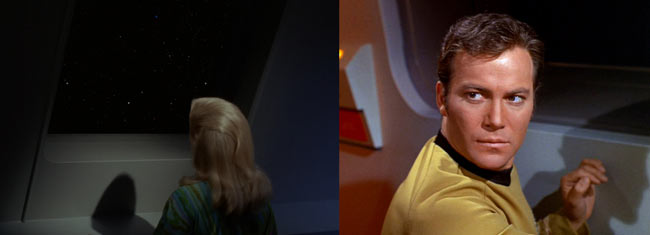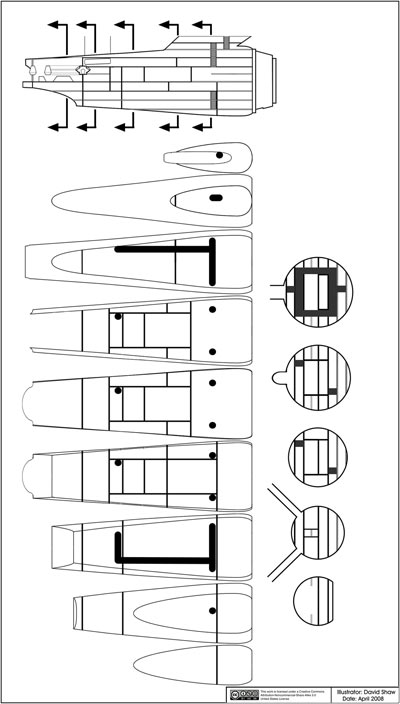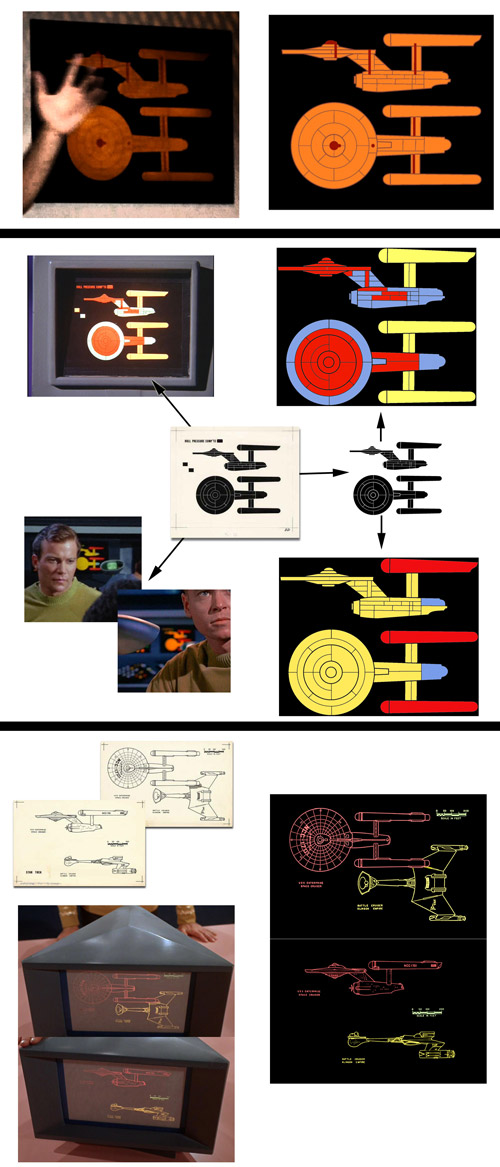Basically, in lieu of one of the TOS "canned stock shots" we saw so often, they replaced that shot with one showing the "orbital dockyards" above the starbase. You can see other ships in the distance, and you can see a burned out area at that location on the Enterprise hull, with repair work going on around it.Interesting point... I don't recall if I've actually seen the remastered episode at this point (I have the old DVDs and the version I bought for iTunes was the original), so other than the effects shots shown on YouTube and in screen captures, I'm not sure how the changing of the bulb was presented in the context of the story.It's easy enough to work around that, though, and just figure that the light blew during the trip through the ion storm.
After all, it's not like there's some Loony Toons sign popping up, saying, "HERE'S WHERE THE ION POD WAS, KIDS!"
But you are correct in that nothing originally filmed would have said what was happening beyond "repairs".
I also think that this was just a "light bulb," and that they're just replacing it. The only real place that CRA and I differ is where the ion pod deploys from... he has it leaving the ship at the B/C "teardrop" while I have it being dragged behind the ship from the "red fantail hatch."
I've always found the "ion pod" to be a pretty silly concept... the major deficiency of this episode, IMHO, was having a MANNED "sensor drone," which is effectively what it is.
It makes absolutely no sense to have the "pod" be physically attached to the ship (as in how that "bulb" is attached) because there is no way to justify it needing to be "ejected."
My "best explanation" is that the pod is used to take specialized sensor reading that require isolation from the "background noise" of the ship. So it's basically an unpowered glass sphere with a chair and a sensor suite, and an extremely-low-powered, optically-based (ie, non-interfering) comm device. It literally is dragged behind the ship at a distance, to permit this "limited background noise" operation. Think of it like a submarine's "towed array" in that sense.
Maybe the issue with it being manned is that, based upon how delicate the readings are, even the noise from a single microprocessor-type device would spoil your readings?
Anyway, I envision this thing needing to be dragged, not by a "tractor beam" but by a physical cable, some distance behind the ship. In order for that to work, the ship needs to have its deflector shields down (otherwise, the shields would just slice through the tow-cable).
THAT explains, to me, why this would happen as it did... the Enterprise is just fine handling an "ion storm" with its shields up, but with shields down, she's vulnerable. The ship has standing orders from "Starfleet Silly Science Command" to take uber-accurate readings of ion storms if they encounter them, using this special piece of hardware. This isn't a "starfleet-wide" standing order, just one given to a few (perhaps just one?) ship as an "additiona duty" to support the science division admiral's "pet project?"
So, the ship is required to put itself at risk, but the idea is to manage that risk. Leave the shields down long enough to get a few readings in the "low-background-noise pod" but retract it in time to get the shields back up and prevent any serious damage from occurring.
The part that makes NO sense, under any circumstances, is that the guy IN the pod is working without any on-ship support. When Kirk gave the command to recover the pod, it shouldn't have been Finney who was responsible for hitting that particular switch, but in the context of the episode, it was, it seems.
Since Finney didn't obey the command to "self-recover" when it was given, Kirk had to hit his command chair's "raise the shields" button, which ends up making the ship "safe" but also cuts the tow-cable (and the air supply, fiber-optic communication line, etc) to the pod.
In normal circumstances, they could just circle around and recover the pod, beam him back aboard, etc, but with an ion storm, they would have a hard time locking on with transporter, or even locating this "no emissions" pod at all... meaning by the time they found it, IF they found it, he'd certainly be dead.
Until Kirk raised the shields, the ship was essentially like an airplane in a lightning storm... and I'd say that it just happened to catch a single "lightning strike" on that particular running light.
That's MY take on it. I think it's similar to CRA's.
Now, as for why that item really CAN'T be a manned device... see this:

(And remember, this is on my 1067' long ship... it'll be slightly smaller if you stick with the 947' ship.)
This could be a dome on the end of a "capsule-shaped coffin" but as a useable working space... not so much. And if it weren't being deployed outside of the ship... Finney would literally be INSIDE THE HULL the entire time anyway, no more or less protected than the bridge crew (with their overhead window) anyway!










